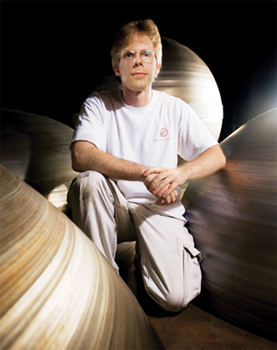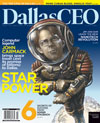Twenty-six teams from seven nations signed up, including Carmack’s Armadillo Aerospace. On October 4, 2004, famed aircraft designer Burt Rutan won the prize with SpaceShipOne, a “spaceplane” that was first carried 46,000 feet up in the air on the back of another plane and then released. The development of SpaceShipOne was funded by Microsoft billionaire Paul Allen at a rumored cost of $26 million, far less than a comparable Lockheed design would probably cost.
SpaceShipOne is a beautiful and elegant design, lauded for its clever simplicity. Armadillo’s challenger was simple, too. Perhaps too simple. By contrast to SpaceShipOne, the pencil-nub-like cone looked crude and obviously handmade. It crashed just a couple of months before Rutan won the prize. But Armadillo Aerospace came close to the same goal for only a fraction of the price. Milburn estimates Carmack has spent only around $2 million. Carmack and Armadillo did not consider losing the Ansari X Prize a failure. Crash and burn can often be crash and learn.
“It was a nice goal, but it was never our ultimate goal,” Carmack says. Now, the team is preparing for the next X Prize Cup challenge in Las Cruces (this time sponsored by NASA).
“What Rutan did was get rid of the giggle factor,” Milburn says. “He flew to the edge of space and back twice. And now people can take private aerospace development seriously.”
So seriously, in fact, that a number of prominent investors are paying more than lip service to the idea of space tourism. Virgin Airlines’ Richard Branson, who is funding Rutan’s development of SpaceShipTwo, envisions his airline offering first-class seats to space in the not-too-distant future. California gazillionaire Dennis Tito became the first space tourist in 2001, spending seven days in the space station and paving the way for other millionaires who got in a rapidly growing line right behind him. As of press time, Anousheh Ansari is reportedly in Russia, close to becoming the first female space tourist and being trained for her first trip into space. A Japanese businessman who is just in front of Ansari on the waiting list has been training with her.
“We see space travel as a $20,000 trip,” Milburn says. “And competition will drive the price down.”
If not, there’s always the possibility of other profitable space ventures. “There are asteroids with more platinum than there is on Earth,” Carmack says.

“Getting people outside of Earth’s orbit is a very risky venture, and the costs are very high because of all the safety precautions necessary for NASA,” says Dr. Greg Earle, a professor of physics at the William B. Hanson Center for Space Sciences at the University of Texas at Dallas. “Still, it could benefit everyone if they could cheaply launch satellites for consumer applications into orbit. It’s a market worth billions.” [See “Next Stop, Outer Orbit,” p. 30.]
The $64 billion question is whether a team of eight rocket enthusiasts in Dallas can achieve on a budget what took thousands of scientists from America and Russia hundreds of billions of dollars and millions of hours to do. Peter Diamandis of the X Prize Foundation is optimistic.
“Armadillo have had an unusual philosophy of build and test, where they have produced more prototypes than any other design shop I’ve seen and have been on a tremendous learning curve,” he says. “They’re building hardware for pennies on the dollar, far less money than a typical NASA contractor charges for just a paper study. This is how breakthroughs happen.”
And Armadillo is already on the cusp of achieving some commercial success: Extreme skydivers have inquired about the possibility of using Armadillo rockets to propel them to extraordinary heights from which to jump. The academic and scientific communities have also inquired about the possibility of sending payload to sub-orbital (and in the future, orbital) heights. And Milburn says some in government circles have shown interest in Armadillo’s R&D approach. But Carmack has his eyes on the heavens, and if he can shake up the order of how to get there, so much the better.
“NASA can spend hundreds of billions of dollars and still do amazing things, but it’s not the right way to go about it,” he says. “If individuals want to go to the moon or go to Mars, we have the resources to make that happen, and I don’t see why we shouldn’t.”






